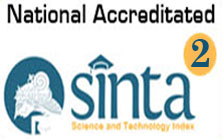Peningkatan Protein dan Vitamin B melalui Pemberian Whey dan Lerry pada Produk Nata
Keywords:
Nata, Lerri, Whey tofu, Thickness, Nutritional valueAbstract
Background: Rinse or rice water lyri and whey tofu is a waste generated by many households and home industries are thrown away. Whereas this waste is still a lot of nutrients that still exist such as carbohydrates, proteins, and vitamins. Waste lerri and whey know this can still be utilized to nata by using bacteria Acetobacter xylinum, so it is expected can also increase economic value of society. Objective: To know the effect of whey tofu substitution on thickness, nutrient content and vitamin B1 nata de lerri. Method: This research is purely experimental, using Completely Randomized Design (RAL) consisting of 5 treatments and each repeated 3 times. Where the free variable is media formula nata, namely rice water washing medium (lerri) and whey knows F1 (100: 0)%; F2 (75: 25)%; F3 (50: 50)%; F4 (25: 75)%; F5 (0: 100)%. The dependent variable is nata thickness, nata nutritional value (moisture content, crude protein content, coarse fiber content, vitamin B1) and organoleptic receiving power. Result: In this research there are five formula of nata de lerri substitution whey know that do. But in practice 2 formulas did not work, namely F4 and F5, because the product remains liquid and cloudy white. This is possible fungal contamination that occurs due to a technical error (less sterile). For thickness nata de lerri, the highest result is the formula F1 with a thickness of 1 cm and the lowest F3 with a thickness of 0.5 cm. But for the results of testing the water content, ash content and highest crude protein content is F3 with a water content value 99.93%, ash 0.34%, crude protein content 1.35%. But from the test results of vitamin B1 all formula and water lerri not detected, this is possible because of the error of the test equipment.
Downloads
References
Budiyanto.K.A. 2004. Mikrobiologi Terapan. Edisi Pertama. Cetakan ketiga. UMM Pres. Malang
Djajati, Sri U, Sarofa.,Syamsul A. 2006. Pembuatan Nata de Manggo. Jurusan Teknologi PanganFTI-UPN Jatim
Doddy A darmajana. 2003. Pengaruh Ketinggian Media dan waktu Inkubasi terhadap beberapa Karakteristik Fisik Nata de Soya. Jakarta : Balai Pengembangan Teknologi Tepat Guna- LIPI
Effendi, Daika S., S.Utami. 2006. Pengaruh Penggunaan Bahan Dasar dan Jenis Gula terhadap Tebal Lapisan dan Uji Organoleptik Nata. Program Kreatifitas Mahasiswa. Jurusan Biologi FPMIPA IKIP PGRI Madiun.
Hesse S dan T Kondo. 2005. Behavior of cellulose production of Acetobacter xylinum in 13C-enriched cultivation media including movements on nematic ordered cellulose templates. J. Carbohydrate Polymers (60): 457–465
Heryawan, K. 2004. Pengaruh Konsentrasi Gula dan Lama Waktu Fermentasi Terhadap Mutu Nata de Pina. Skripsi. Jurusan Teknologi hasil Pertanian Unsyiah Banda Aceh.
Kurotsumi, A., C, Sasaki., Y, Yamashita.,Y, Nakamura, 2009. Utilization of Varius Fruit Juice as Carbon Source for Production of Bacterial Cellulose by Acetobacter xylinum NRBC13693. Journal of Carbo Vol 79 Page 333-335.
Klemm, D., Heublein, B., Fink, H.-P., & Bohn, A. (2005). Cellulose: Fascinating biopolymer and sustainable raw material. Angewante Chemie International (44): 3358–3393.
Lina Susanti. 2006. Perbedaan Penggunaan Jenis Kulit Pisang terhadap Kualitas Nata. Semarang: UNNES
Margaretha, Y.P. Pengaruh Kadar Gula terhadap Pembuatan Nata de Yam. Skripsi. Jurusan Pendidikan Matematika dan Ilmu Pengetahuan Alam. Universitas Sanata Dharma. Yogyakarta
Nadia. 2010. Keju Halal yang Lezat. Lembaga Pengkajian Pangan, Obat-obatan dan Kosmetika MUI
Nurdiyanto. 2008. Kualitas Nata dari Bahan Bekatul (Nata de Bekatul) dengan Starter Bakteri Acetobacter xylinum. Surakarta. UNMUH Surakarta.
Nurhasanah, Y,Siti.,Nelly.,REka, Imam.2010. Potensi Limbah Air Cucian Beras Sebagai Media Perbanyakan Bakteri Probiotik Tanaman. Laporan Akhir Program Kreatifitas Mahasiswa. IPB
Park WI, HS Kim, SM Kwon, TH Hong, HJ Jin.,2009. Synthesis of bacterial celluloses in multiwalled carbon nanotube-dispersed medium. K. carbohydrate polymers (77):457-463
Piluharto, Bambang. 2001. Studi Awal Penggunaan Nata de Coco sebagai Membran Ultrafirasi. Tesis. Program Magister Kimia. Institut Teknologi Bandung.
Rachmat, A.,Agustina F. 2009. Pembuatan Nata de Coco dengan Fortifikasi Limbah Cucian Beras Menggunakan Acetobacter xylinum. UNDIP. Semarang.
Ratnawati D. 2007. Kajian Variasi Kadar Glukosa dan Derajat Keasaman (pH) pada Pembuatan Nata de Citrus dari Jeruk Asam (citrus Lemon L)Jurnal Gradien Vol 3 (2) Hal 257-261
Rindit Pambayun. 2002. Teknologi Penggolahan Nata de Coco. Yogyakarta: Kanisius
Downloads
Published
How to Cite
Issue
Section
License
Copyright notice
Ownership of copyright
The copyright in this website and the material on this website (including without limitation the text, computer code, artwork, photographs, images, music, audio material, video material and audio-visual material on this website) is owned by JURNAL INFO KESEHATAN and its licensors.
Copyright license
JURNAL INFO KESEHATAN grants to you a worldwide non-exclusive royalty-free revocable license to:
- view this website and the material on this website on a computer or mobile device via a web browser;
- copy and store this website and the material on this website in your web browser cache memory; and
- print pages from this website for your use.
- All articles published by JURNAL INFO KESEHATAN are licensed under the Creative Commons Attribution 4.0 International License. This permits anyone to copy, redistribute, remix, transmit and adapt the work provided the original work and source is appropriately cited.
JURNAL INFO KESEHATAN does not grant you any other rights in relation to this website or the material on this website. In other words, all other rights are reserved.
For the avoidance of doubt, you must not adapt, edit, change, transform, publish, republish, distribute, redistribute, broadcast, rebroadcast or show or play in public this website or the material on this website (in any form or media) without appropriately and conspicuously citing the original work and source or JURNAL INFO KESEHATAN prior written permission.
Permissions
You may request permission to use the copyright materials on this website by writing to jurnalinfokesehatan@gmail.com.
Enforcement of copyright
JURNAL INFO KESEHATAN takes the protection of its copyright very seriously.
If JURNAL INFO KESEHATAN discovers that you have used its copyright materials in contravention of the license above, JURNAL INFO KESEHATAN may bring legal proceedings against you seeking monetary damages and an injunction to stop you using those materials. You could also be ordered to pay legal costs.
If you become aware of any use of JURNAL INFO KESEHATAN copyright materials that contravenes or may contravene the license above, please report this by email to jurnalinfokesehatan@gmail.com
Infringing material
If you become aware of any material on the website that you believe infringes your or any other person's copyright, please report this by email to jurnalinfokesehatan@gmail.com.



















